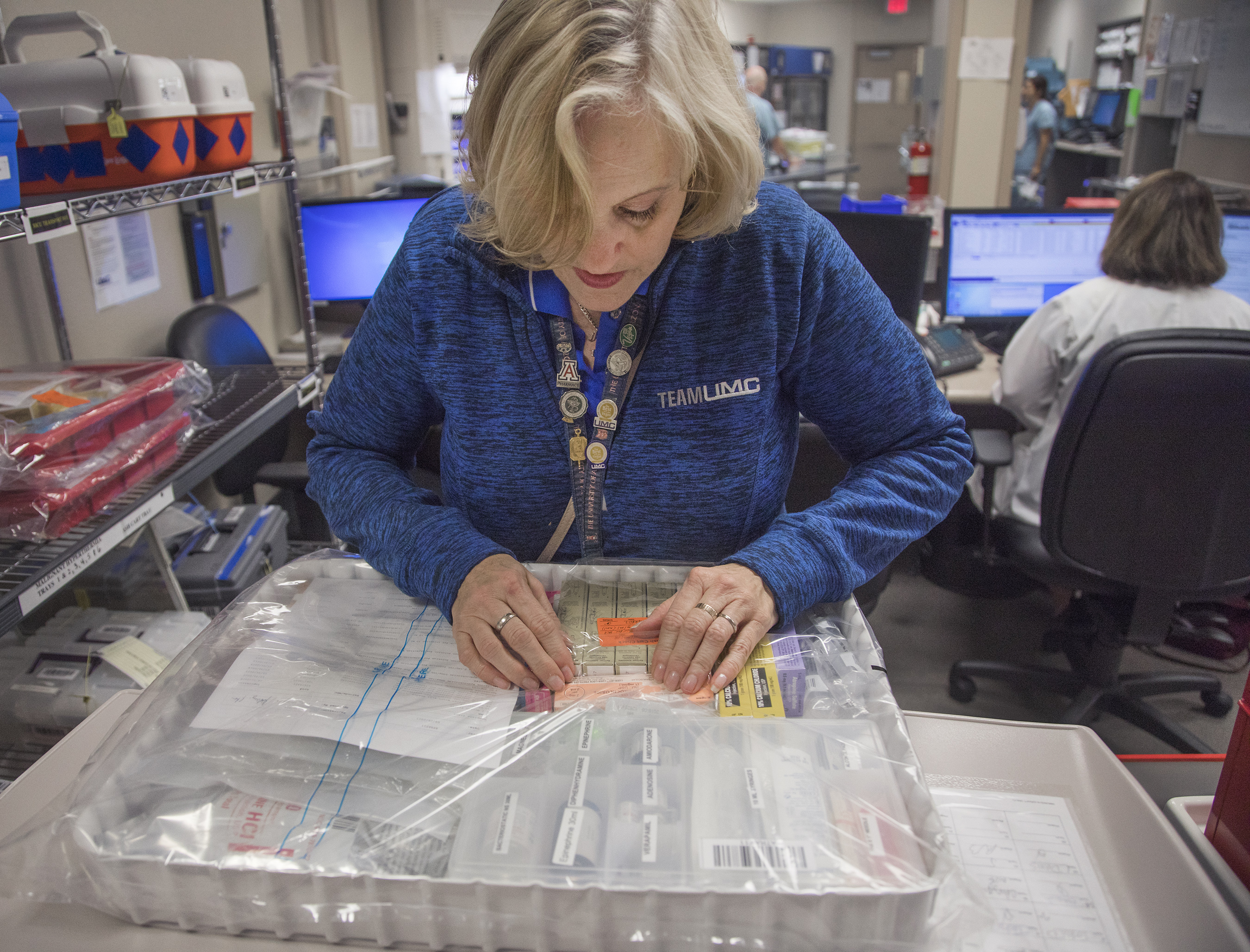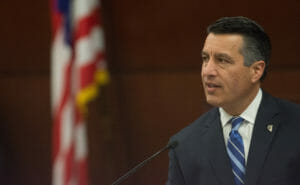Opioids in Nevada: How one new law attempts to address the epidemic and why some doctors are pushing back

There’s a chronic pain patient with a rare condition, scared because his primary care doctor of 21 years told him suddenly one day that he will no longer write him prescriptions for the medication that keeps him functioning every day.
There’s a doctor who — though he says he’s gotten some patients off of their narcotic pain medications — feels like he’s now playing detective instead of building trusting relationships with his patients.
And, then, there’s a massive nationwide opioid epidemic that claimed the lives of 387 Nevada residents in 2016, according to preliminary estimates. Six in 10 of those deaths were caused by natural or semi-synthetic opioids — prescription narcotics such as codeine, morphine, hydrocodone or oxycodone — while another two in 10 were caused by heroin.
In Nevada, the opioid epidemic is the story of the governor who promised to fight it, the boards and associations looking for workable solutions to help and the doctors and patients living with the reality of it — and how solutions are easier said than done.
Opioids, once seen as a “wonder drug” by doctors and patients alike, have slowly become public enemy number one, and doctors and patients, used to decades of pain being treated as the “fifth vital sign,” have been left to adjust to a new paradigm. Where they once might’ve written an opioid prescription without a second thought, doctors are now being asked to reconsider some of their basic assumptions: Is this prescription the best way to treat pain? To what extent should pain be treated? Is the prescription worth writing in light of the potential side effects?
But, beyond the overarching philosophical and ethical questions, doctors are also being required by a new state law, which kicked into effect on the first of the year, to change some of their specific practices for writing opioid prescriptions.
Prescribers — everyone from your family doctor to the dentist performing your root canal — are required to obtain and review a patient’s medical history or records (or make a good faith effort to do so), conduct a physical examination, assess the patient’s mental health and the risk of abuse of addiction, discuss alternative treatment options and obtain a written, informed consent before writing an initial (14-day-or-less) prescription for opioids or other controlled substances.
For longer prescriptions, there are additional requirements: Entering into a prescription medication agreement with a patient, determining an evidence-based diagnosis for pain and considering referring the patient to a pain management specialist — if the patient is receiving a certain level of pain medicine each day.
Doctors have their gripes with the law, complaining about the paperwork and adjusting their workflows. But they have real questions too. What counts as an “initial prescription”? What’s “informed consent”? How about “inappropriate prescribing”?
And then there are the doctors who believe the bill is unworkable as it is now. Primary care doctors who no longer feel comfortable writing prescriptions for controlled substances. Optometrists unsure how they’re supposed to assess a patient’s mental health. Oncologists opting to retire early.
“There are so many issues of this law that have not been fully defined, it is almost impossible,” said Dr. Jim Marx, a pain specialist in Las Vegas, at a workshop last week hosted by the Board of Medical Examiners.
Those sentiments stand in stark contrast to the broad support the legislation, spearheaded by the governor’s office, received at the Legislature last year, as well as the significant time and effort put in by the governor’s staff, licensing boards and trade associations prior to the legislative session to craft a compromise bill that would be workable for prescribers while taking steps to mitigate the opioid epidemic.

“While we have made progress, prescription drug abuse is tearing at the fabric of our families and communities,” Sandoval said in his State of the State address early last year. “For this reason, last summer I convened a Statewide Prescription Drug Summit with participation from 500 stakeholders, that included legislators, health-care professionals, law enforcement, judges and victims.”
“Based on recommendations from the Summit, I will introduce the Controlled Substance Abuse Prevention Act, which provides more training and reporting and heightened protocols for medical professionals … I look forward to ridding the state of the scourge of opioid abuse.”
***
In the months leading up to the legislative session — in the wake of the governor’s drug-planning meeting in June 2016 and the two-day prescription drug summit in August 2016 — the governor’s office brought together the state’s medical licensing boards and associations to shape the contours of the legislation that would ultimately become the governor’s Controlled Substance Abuse Prevention Act.
The Nevada State Medical Association, which represents MDs, sent three representatives, a primary care doctor, a pain management doctor and an emergency room doctor, to discuss conceptual prescriber guidelines. The Nevada Osteopathic Medical Association, the trade association for DOs (doctors of osteopathic medicine), attended. The various licensing boards sent representatives, too.
“A lot — and I mean a lot — of time and effort was put in this,” said Dr. Bruce Fong, president of the osteopathic association. “There were numerous meetings trying to help basically hammer this thing out, what people were willing to accept and not willing to accept.”
In particular, the Board of Pharmacy, which is responsible for issuing all controlled substance licenses whether the applicant is a doctor, podiatrist or optometrist, played a key role in helping the governor’s office bring the legislation to life. Paul Edwards, the board’s general counsel, said the idea that this bill was written secretly in a back room by three people is “absolute nonsense.”
“I’ve never seen a bill that’s been so well vetted and broadly vetted,” Edwards said. “It’s not just the boards and the governor’s office and the health department but the medical association and the nursing association and the hospital association. The base of people that the governor’s office talked to was, frankly, quite astounding.”
Over a series of meetings, they worked through some of the early kinks of the legislation. For instance, the state medical association pushed back on a proposal for mandatory urine drug screenings in favor of allowing providers to request drug screenings when necessary. They also advocated for making an “initial prescription” be as long as 14 days, not limited to seven.
Edwards said his sense coming out of the meetings was that everyone was pretty much on board with the bill. Fong said it was a “compromise” but “a heck of a lot better” than what could’ve come out of the meetings.
Still, no one quite knew what the bill would look like once it was sent off to legislative staff for drafting, though the governor’s staff outlined the bill to The Nevada Independent in late February. The legislation, known as AB474, was introduced into the Legislature on March 27 and shipped off to the Assembly Health and Human Services Committee for a hearing a week later.
At that hearing in early April, a long list of supporters came out to testify in favor of the bill: the Board of Medical Examiners, the Board of Nursing, the Board of Pharmacy, the Board of Dental Examiners, the Nevada Osteopathic Medical Association, the Nevada Association of Health Plans, the Nevada Orthopaedic Society, the Nevada Advanced Practice Nurses Association — and the list goes on.
In fact there were only three people to testify in neutral— a pharmacist testifying as a private citizen who expressed concerns about “adverse scenarios for all health-care providers and patients,” a deputy public defender from Washoe County with concerns over statute of limitations in a part of the bill dealing with law enforcement and Catherine O’Mara, executive director of the Nevada State Medical Association. No one testified against the bill.
In her testimony, O’Mara brought up several specific concerns about the bill, including whether doctors would still be allowed to exercise their clinical judgment to write concurrent prescriptions for separate ailments and how doctors would obtain “informed consent” from patients to obtain an initial prescription. She also said she hoped to continue to work on parts of the bill dealing with reporting overdose and inappropriate prescribing.
“We are neutral to this pending some clarification, and we really appreciate being part of the process,” O’Mara said at the time.
After one amendment clarifying that reports of cases of drug overdoses should be made to the state’s chief medical officer, removing access for paramedics to the database and exempting veterinarians from the law, the bill passed the Assembly in mid-May with unanimous support.
By the time it came up for a hearing in the Senate Health and Human Services Committee a couple of days later, all the boards and associations testified in support of the bill. No one testified in the neutral or in opposition.
“We are in support of A.B. 474,” O’Mara said. “We believe there is more work to do on this bill regarding regulations, and we want to be part of that.”
O’Mara noted that the association wanted to see a few regulations adopted to clarify certain sections of the legislation, such as the definition of “inappropriate prescribing,” but that they looked forward to being a part of those discussions.

Sen. Joe Hardy, a physician by trade, posed some critical questions at the hearing too, including the issue of what counts as an “initial prescription,” but eventually ended up voting in favor of the bill. Hardy, in a recent interview, said that he felt comfortable doing so at the time because he said there was a “virtual promise” made in behind the scene discussions with the governor’s staff that the boards would come together and write regulations to aid the implementation of the bill.
“We all agreed we need to do something,” Hardy said. “The bill — flawed as it was — we felt a certain level of comfort in that there were going to be regulations that would address what was going to happen and all of the boards were going to get together.”
The bill passed unanimously out of the Senate on June 2 and was signed by the governor two weeks later on June 16.
***
In the six months since then, the governor’s office and the various boards have been working on educating their members about how to comply with the new law, which has been in effect since Jan. 1. The licensing boards collaborated on a white paper to simplify the 52-page law into a five-page digest and compiled a set of frequently asked questions.
The governor’s office, the boards and the associations have all been holding classes and town halls to educate prescribers about the new law. They’ve also all been fielding calls and emails with questions.
“One thing that’s been surprising to me, but satisfying, is you get a doctor on the phone and walk them through it and say, ‘This is what the bill is trying to do.’ I’ve had several to say, ‘That’s just good medicine, we kind of do that anyway. We already do this in our office anyways. We don’t know how you could not be doing these things. Well, I don’t understand what the hubbub’s about,’” said Edwards, with the pharmacy board. “We’ve gone to great lengths to make sure people understand what’s in there and dispel the rumors.”
Larry Pinson, executive director of the pharmacy board, estimates that about 90 percent of doctors he receives calls from are okay with the bill after he’s walked them through how to comply.
“I think our primary role right now is one of education. That’s got to be our focus,” Pinson said. “To do everything we can for all of the practitioners, pharmacists as well, to know what the bill is all about, what it’s trying to accomplish and how to do it, that has to be our focus.”
But the education process has only gone so far to help those doctors with lingering concerns about the bill.
For its part, the Nevada State Medical Association still would like to see the Board of Pharmacy adopt regulations clarifying if “informed consent” paperwork can be shared among multiple doctors in a single practice, whether certain sections of the law apply to all controlled substances or just opioids and what “inappropriate prescribing” means.
“The problem is there really are some true ambiguities in the bill, and there are some true areas of confusion that need to be clarified,” O’Mara, the association’s executive director, said in a recent interview.
The pharmacy board has been somewhat reluctant to propose regulations that, in its view, stray too far away from prescribing and into the practice of medicine. Edwards said in a Tuesday interview that he didn’t see a lot of a need for the board to consider additional regulations at this time; however, both O’Mara and the governor’s office said Thursday that the pharmacy board had agreed to start work on regulations clarifying some of the prescriber guidelines in the law.
If the pharmacy board does decide to adopt regulations, it may go a significant way toward addressing the concerns of doctors who still have questions about how to adhere to certain portions of the law. There was an outcry from doctors at a recent Board of Medical Examiners workshop that a set of disciplinary regulations were being proposed when they felt there was still a lack of clarity in how to follow the law.
"That just scared people, frankly, because it talked about five violations and your license will be revoked,” O’Mara said. “I think it was the combination of two things. 'Hey, there’s a big change, but no one can clearly articulate what you need to do to comply,' and, 'Here’s a regulation that tells you if you mess up five times you lose your license.'"
At the workshop, one plastic surgeon described the proposed, five-strikes-and-you’re-out regulation as draconian and worried that doctors would be penalized for minor infractions like forgetting to write a patient’s date of birth on a prescription.
“They have to be absolutely perfect to not get a hit and go on the bad boy list,” the plastic surgeon, Dr. Jeffrey Roth, said.
But there are pros and cons to putting certain clarifying details in regulation. For instance, doctors want to know what inappropriate prescribing is, so they have some standard to adhere to. However, what’s inappropriate for one prescriber might not be for another, and setting a definition in regulation could end up requiring doctors to adhere to a strict standard as opposed to allowing the various licensing boards to use their discretion when a disciplinary case arises.
But that discretion is cold comfort for doctors who worry that five minor violations could potentially lead to a loss of license and end their careers. Even though Ed Cousineau, executive director of the Board of Medical Examiners, told the doctors at the workshop that the board’s aim is not to discipline doctors acting in good faith, some doctors still worry about what happens if there’s a changing of the guard at the board and there’s a new interpretation of the law and regulations down the line.
“The regulations heretofore have been somewhat half-baked. They’re raw and they rub the providers raw,” Hardy said. “We’ve got the perfect storm.”
It’s not just the doctors who have concerns, either. Some of the smaller boards, including the optometry and dental examiners board, have concerns about the way the law applies to the specific ways their prescribers write for controlled substances.

For instance, optometrists are limited to writing a three-day prescription for controlled substances, often for glaucoma or a corneal abrasion. Caren Jenkins, executive director of the optometry board, said that she’s not sure that optometrists will be able to compile a full medical history of the patient, conduct a physical examination and assess a patient’s mental health.
“For an optometrist to get a full medical history of the patent for all providers of health care for a three day prescription with no refills available and conducting a physical examination of the patient when my optometrist’s are trained to analyze, diagnose and treat eyes is quite an onerous burden and I’m not certain they’re qualified,” Jenkins said.
Stephanie Woodard, a clinical psychologist with the Division of Public and Behavioral Health, said that the state would never ask a prescriber to work outside their area of scope, such as asking an optometrist to make a full evaluation of a patient’s mental health. However, she pointed to a link on the state’s Prescribe 365 website with a five-minute opioid risk assessment tool that prescribers can use to assess a patient’s potential vulnerabilities.
“We’re not asking somebody to go outside their scope. We want them to understand there are inherent risks, other risks, they’re also evaluating for,” Woodard said.
The dentists, who write prescriptions for acute pain and rarely write for more than 14 days worth of pills, are in a similar boat as the optometrists.
“It’s not that they shouldn’t have been included at all, but there should have been some recognition that their prescribing methods and habits are not the same as your oncologists or pain management doctors,” said Melanie Bernstein Chapman, general counsel for the Board of Dental Examiners. “But they understand that this is the law and this is what we’re going to live with.”
And then there’s the nursing board, which reports smooth sailing. Like the other boards, the nursing board has provided trainings to their advanced practice registered nurses — the only nurses allowed to prescribe controlled substances, should they so choose — and has sent out email blasts communicating to the coming changes to their licensees.
“The nurse practitioners that have contacted us have been very thoughtful, whether they agree (with the law) or not. ‘I need to be compliant. What do I need to do to be compliant?’” said Cathy Dinauer, executive director of the Board of Nursing. “It’s the law, we’re going to enforce it, and so again, it’s just a matter of providing the education.”
Though some of the boards are in the process of adopting regulations to address the bill’s continuing education requirement for opioid prescribers, only the Board of Medical Examiners and Board of Podiatry are discussing language to address potential violations of the new law. Most of the boards believe their existing regulations are sufficient to address the new law.
For its part, the Board of Medical Examiners is taking its regulations back to the drawing board and putting together a working group that will study the new law and develop any necessary regulations. The group will include at least two board members, a representative of the Legislature, representatives from the Nevada State Medical Association and other industry stakeholders.
“Certainly the intent of AB474 is appropriate and laudable, but it’s going to take a little time to work out all the nuances that are articulated therein,” Cousineau, the board’s executive director, said. “But the board’s position is we recognize that this is the law and we intend it to follow it to the best of our abilities.”
***
A working group and any forthcoming regulations will take time. But it’s day 14 of the implementation of the law, and the clock isn’t going to stop anytime soon.
That’s why the governor’s office is continuing to educate people about what the law does and doesn’t require.
“Change is hard. But this is a real problem that’s facing Nevada, and we have a lot of data to say that overprescribing is happening. We know it’s a problem. Something has to be done,” said Elyse Monroy, the governor’s health-care policy analyst. “Are we surprised there’s frustration with making the necessary changes to comply? Not really, but that’s why we did everything we could to get ahead of it — make a compliance checklist, get out to talk to people and talk to prescribers, participate in town halls and answer individual questions.”
The goal of the law, she said, is to make sure doctors are having ongoing conversations with their patients. If a doctor feels like they can’t comply with the law based on what the patient’s need is — if they need to write an initial prescription longer than 14 days or more than a year’s worth of medication over the course of 365 days — he or she just has to document why they decided to do so, Monroy said.
“Our approach here with the bill was not to say every patient, everywhere in every instance only gets seven and that prescriber can only prescribe seven days,” Monroy said. “It’s up to you the prescriber if you want to prescribe. If you want to prescribe for longer than 90 days, you can do that if it’s medically necessary.”
Much of what the governor’s office is focused on is combatting specific pieces of misinformation. For instance, Monroy said that some people have interpreted the law’s “prescribe 365” provision — which, in short, states that a patient shouldn’t receive more than a year’s worth of medication in any 365-day period — to mean prescribers will cut patients off from their opioids after a year.
How “prescribe 365” is supposed to work is if a doctor sees a patient who has received 200 days worth of hydrocodone in a 90 day period, they should only prescribe 165 more days of hydrocodone over the next 275 days. However, if the doctor decides that he or she needs to prescribe over that 365 day amount for whatever reason, he or she can still do so but must make a note explaining the decision in the patient’s record.
“It’s not intended to cut patients off,” Monroy said. “That’s a very scary kind of narrative that makes me feel for patients who are dependent on these at this point.”
They also want to let doctors know that the legislation is only one piece of the puzzle and they’re not trying to pick on prescribers. The governor’s office developed a number of different focus areas, including criminal justice intervention and intelligence sharing, to combat the opioid epidemic out of the August 2016 summit.
The Division of Public and Behavioral Health, for its part, just hired a public health law enforcement coordinator to reside within the Attorney General’s office to provide more coordination in the state’s opioid response.
State officials also noted they don’t endorse prescribers unilaterally deciding that they are no longer going to prescribe opioids to patients for whom prescribing them would be appropriate.
“We’ve heard stories about patients going into their prescribers and being turned way at the door and told this bill prohibits them from prescribing,” Woodard, with the Division of Public and Behavioral Health, said. “There is no reason that a patient who has an individual need for pain medication should not be prescribed that medication.”
But the state is cognizant of the fact that change is hard and comes slowly.
“We had doctors at the table when we were doing this bill,” Monroy said. “These are implementable things, but change is hard. We want to be supportive in helping practices make their change.”
